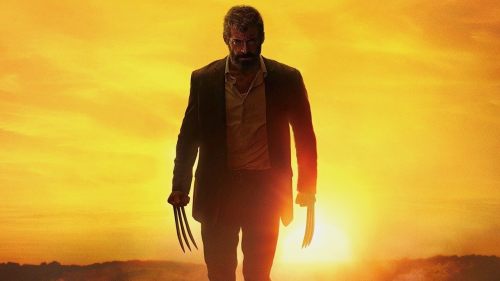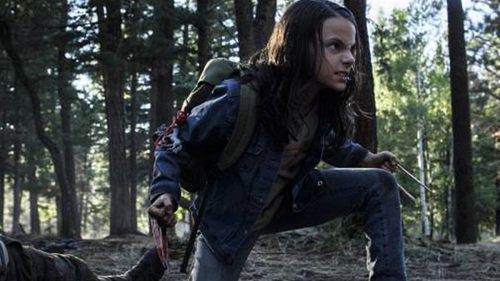LOGAN: The Comic Book Film Fights Itself
Logan is out this now! (Buy your tickets here!) To celebrate, we're featuring a week of articles in honor of everyone's favorite mutant.
Warning SPOILERS for Logan!
You are your own worst enemy. It’s a cliché; but also a powerful recurring theme in popular fiction. Captain Kirk famously fought himself (or someone disguising themselves as him) in both the Original Series episode “The Enemy Within”, and Star Trek VI: The Undiscovered Country. Superman has fought so many clones, split personalities, or dark mirror images that he should consider investing in therapy. In 1992, Mario was given an evil counterpart in Wario — a slightly fatter, more menacing variation on the video game plumber with a bulbous pink nose and a taste for purple overalls. These characters are intended to reflect the worst of the protagonist back at them, in order to make them question their own utility as a hero. So, it should come as no surprise that Logan, the final X-Men film to feature Hugh Jackman as Wolverine, would squeeze in a doppelganger for Weapon X to square off against.
X-24, as he is referred to by the nefarious corporation that created him, functions much like every other comic book evil twin or clone. He personifies the thing that James Howlett hates the most about himself — his penchant for uncontrolled rage and bloodlust. Up until the point where X-24 is introduced, Logan is a restrained, melancholy affair. Well, it’s as restrained as any movie featuring hillbillies with robot hands and elderly psychics can be. The world outside of the plot — a mass of humanity that is usually just around for the sake of racking up collateral damage in comic book films — is crass, dumb, and oblivious to the drama unfolding around them. They go to casinos, gamble their money away, get drunk on cheap champagne, and guzzle energy drinks in the margins of the frame. It’s the subtlest dystopia committed to the screen in a decade; terrifying because it’s recognizable. Then, X-24 appears alongside Richard E. Grant’s Xander Rice, and the funny book pages start flipping.
It’s not such a drastic tonal shift that it ruins the film, like the nuclear McGuffin and Bruce Wayne’s comical, Wolverine-esque healing abilities in The Dark Knight Rises. But every time the feral beast shows up on screen, it reoriented me back into a realm of the fantastical. It’s a well-worn trope; one that isn’t gussied up and polished to a like-new shine to really work on an emotional level. As a concept, X-24 is a thematic hammer that ensures even the back row of the auditorium gets the point. It sets up the climactic claw-on-claw action of the visceral, punishing third act. Most importantly, it means that Wolverine is killed by himself — an image that must have really tickled Jackman, director James Mangold, and the team of writers that brought his vision to life.
It’s like the comic book movie genre can’t help itself. Directors like Mangold and Christopher Nolan want to elevate the form beyond tights and collapsing buildings. Logan even spends a fair amount of its runtime gently poking fun at the very idea of comic book mythology. But when it’s time to metaphorically pay the bills and give the audience a slam-bang finish with all the trappings of blockbuster cinema, it does. The fight between Transigen’s Reavers and the band of young mutants on the run to Canada isn’t bloated, nauseating, and dull like the end of X-Men: Apocalypse. It’s intimate and emotionally satisfying, but also wrapped up with Logan fighting a mute clone. If the junkyard scene from Superman III was filmed today, it might look something like the final fight in Logan. It’s what keeps an excellent movie from being truly great.
Make no mistake: Logan is excellent. It’s the best work both Jackman and Stewart have done in the X-Men series, and maybe their entire careers. Marco Beltrami’s haunting score, François Audouy’s dusty, consumerist nightmare production design, and John Mathieson’s painterly frames make Logan one of the best comic book movies of all time. Still, this is a comic book movie, so when critics tell you that it’s more than that, that it transcends the genre, they’ve got it all wrong. Logan is expertly made genre entertainment — a Western, mixed with a dystopian sci-fi saga, crossed with a bold family melodrama. It’s also a movie with clones, robot hands, magic potions, and people with ice breath.
That’s OK. I can look past the genre clichés and occasional groan-inducing one-liner. Logan leans into all of the comic book flourishes just enough, without being overwhelmed by them. In the process, Mangold and Jackman made a film that anyone wading into the choppy waters of the superhero genre will have to contend with. The clichés are a glitch, but more than that, they’re a feature. Logan is part of a universe comprised of capes and super-villainy. Often times, we embrace these movies despite their flaws, and occasionally because of them. To the next generation of filmmakers who tackle these enduring stories, I say this: don’t fight yourselves. Don’t fight back against the tenants of the genre. Logan couldn’t escape the truth about who he was and pretend he was someone else. Comic book movies shouldn’t either.



